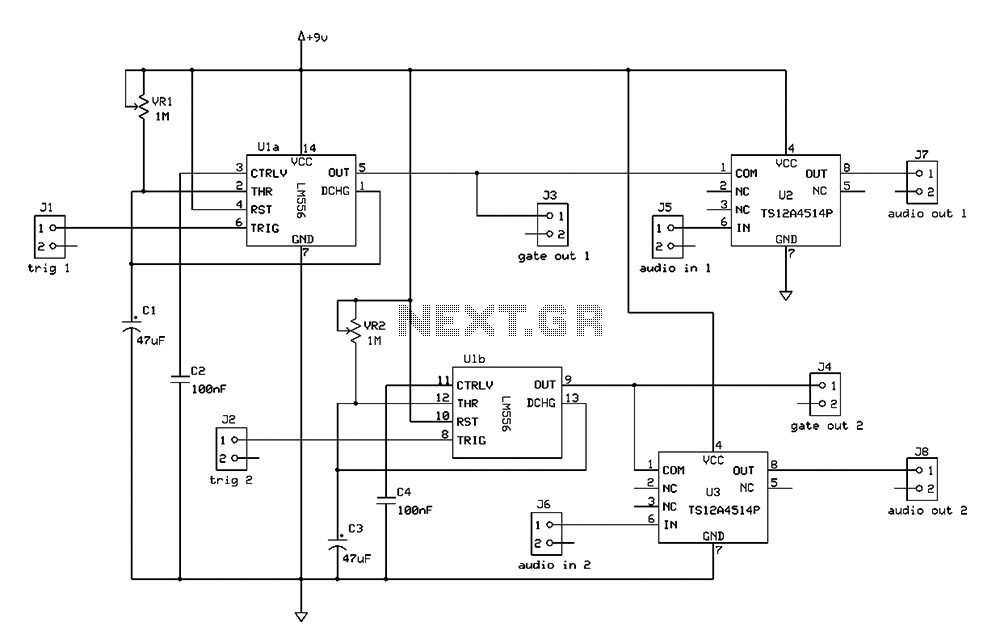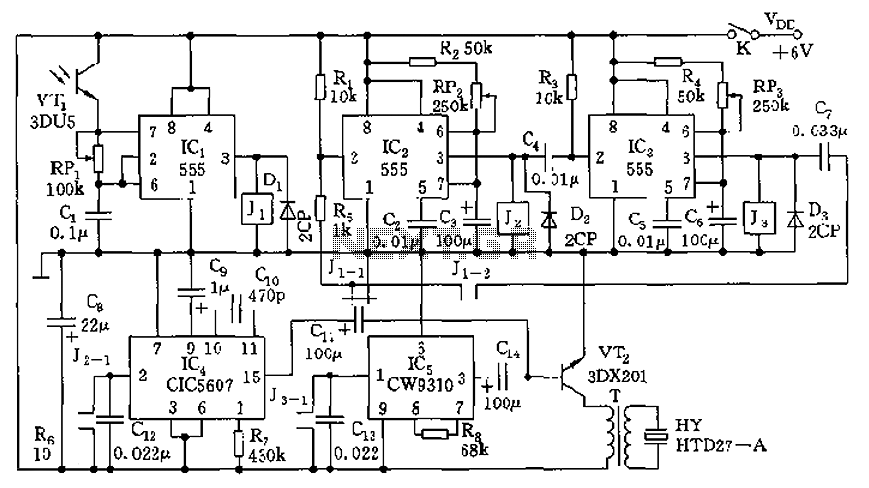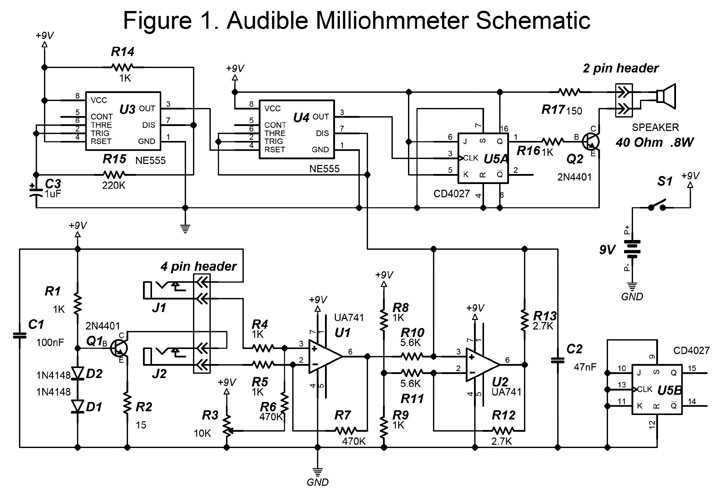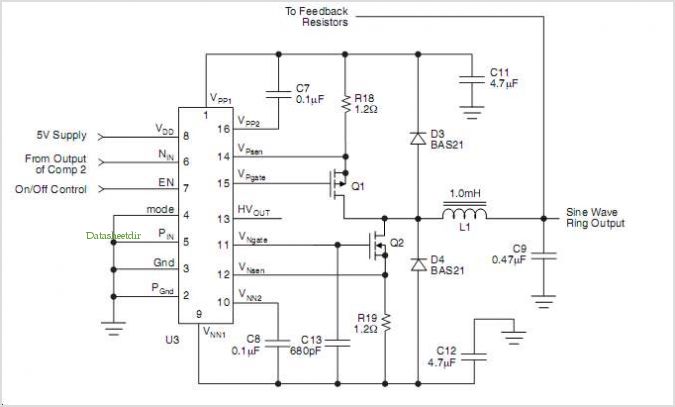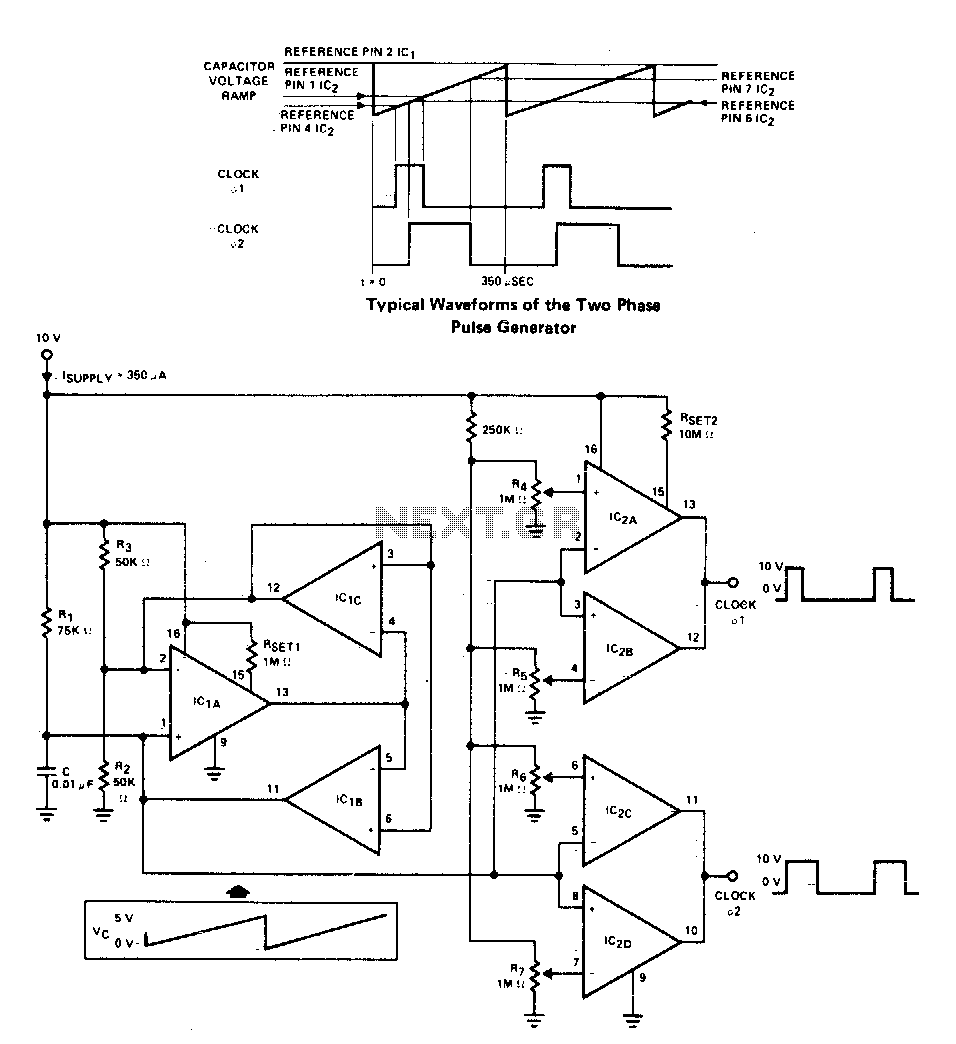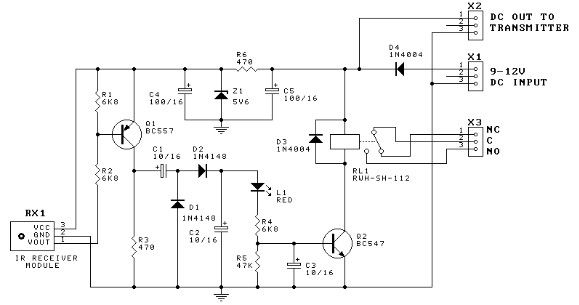
555 ramp generator

The voltage rating of the 470 µF capacitor is not critical, provided it significantly exceeds the maximum power supply voltage, which is 12 volts in this circuit. It is essential to connect this capacitor correctly, observing its polarity. The circuit utilizes a 555 timer IC configured as an astable multivibrator or oscillator. In this instance, the operation will be compared in two different capacitor-charging modes: traditional RC and constant-current. A jumper wire connects test point #1 (TP1) to test point #3 (TP3), allowing the capacitor to charge through a 47 kΩ resistor. Once the capacitor reaches 2/3 of the supply voltage, the 555 timer switches to "discharge" mode, rapidly discharging the capacitor to a level of 1/3 of the supply voltage before starting the charging cycle again. The voltage across the capacitor should be measured with a digital voltmeter, noting the charging rate over time, which will initially rise quickly and then taper off as it approaches 2/3 of the supply voltage, consistent with an RC charging circuit. After removing the jumper wire from TP3 and reconnecting it to TP2, the capacitor will charge through the controlled-current leg of a current mirror circuit formed by two PNP transistors. The voltage across the capacitor should again be measured, observing the difference in charging rates compared to the previous configuration. Connecting TP1 to TP2 allows for a nearly constant charging current, resulting in a linear voltage curve as described by the equation i = C(de/dt). If the charging current is constant, the rate of voltage change over time will also remain constant, producing a "ramp" waveform instead of a "sawtooth" waveform. The capacitor's charging current can be measured by replacing the jumper wire with an ammeter set to measure hundreds of microamps. When connected between TP1 and TP3, a high initial current will be observed that tapers off, while connecting between TP1 and TP2 will show a more stable current. An interesting experiment involves changing the temperature of either current mirror transistor by touching it; warming the transistor will alter the collector current based on the base-emitter voltage. If the controlling transistor (connected to the 100 kΩ resistor) is touched, the current decreases, while touching the controlled transistor increases the current. For optimal current mirror operation, the two transistors should be thermally coupled to prevent significant temperature differences. The circuit functions effectively at both high and low frequencies. Replacing the 470 µF capacitor with a 0.1 µF capacitor and using an audio detector to sense the voltage waveform at the 555's output will produce an audible tone. The capacitor's voltage will change too rapidly for a DC voltmeter to display, but capacitor current can still be measured with an ammeter. In RC mode (TP1 to TP3), both DC and AC microamps should be recorded. Then, in constant-current mode (TP1 to TP2), both DC and AC microamps should again be measured, noting any differences in current readings between the two configurations. Measuring both AC and DC currents is an effective method to determine which circuit configuration provides the most stable charging current.
This circuit demonstrates two distinct methods of charging a capacitor using a 555 timer IC. The first method employs a traditional RC charging approach, where the capacitor charges through a resistor, displaying a characteristic exponential voltage curve. The second method utilizes a constant-current source provided by a current mirror circuit, allowing for a linear voltage increase across the capacitor. The comparison between these two methods highlights the differences in charging behavior, providing insight into the effects of varying current sources on capacitor charging. The use of a digital voltmeter and ammeter facilitates precise measurements, enabling a thorough analysis of the circuit's performance under different conditions. The experimentation with temperature effects on the current mirror transistors further illustrates the importance of thermal management in precision electronic circuits. Overall, this circuit serves as an educational platform for understanding capacitor charging dynamics and the impact of circuit configurations on performance.The voltage rating on the 470 µF capacitor is not critical, so long as it generously exceeds the maximum power supply voltage. In this particular circuit, that maximum voltage is 12 volts. Be sure you connect this capacitor in the circuit properly, respecting polarity! Again, we are using a 555 timer IC as an astable multivibrator, or oscillator. This time, however, we will compare its operation in two different capacitor-charging modes: traditional RC and constant-current. Connecting test point #1 (TP1) to test point #3 (TP3) using a jumper wire. This allows the capacitor to charge through a 47 k © resistor. When the capacitor has reached 2/3 supply voltage, the 555 timer switches to "discharge" mode and discharges the capacitor to a level of 1/3 supply voltage almost immediately.
The charging cycle begins again at this point. Measure voltage directly across the capacitor with a voltmeter (a digital voltmeter is preferred), and note the rate of capacitor charging over time. It should rise quickly at first, then taper off as it builds up to 2/3 supply voltage, just as you would expect from an RC charging circuit.
Remove the jumper wire from TP3, and re-connect it to TP2. This allows the capacitor to be charged through the controlled-current leg of a current mirror circuit formed by the two PNP transistors. Measure voltage directly across the capacitor again, noting the difference in charging rate over time as compared to the last circuit configuration.
By connecting TP1 to TP2, the capacitor receives a nearly constant charging current. Constant capacitor charging current yields a voltage curve that is linear, as described by the equation i = C(de/dt). If the capacitor`s current is constant, so will be its rate-of-change of voltage over time. The result is a "ramp" waveform rather than a "sawtooth" waveform: The capacitor`s charging current may be directly measured by substituting an ammeter in place of the jumper wire.
The ammeter will need to be set to measure a current in the range of hundreds of microamps (tenths of a milliamp). Connected between TP1 and TP3, you should see a current that starts at a relatively high value at the beginning of the charging cycle, and tapers off toward the end.
Connected between TP1 and TP2, however, the current will be much more stable. It is an interesting experiment at this point to change the temperature of either current mirror transistor by touching it with your finger. As the transistor warms, it will conduct more collector current for the same base-emitter voltage. If the controlling transistor (the one connected to the 100 k © resistor) is touched, the current decreases.
If the controlled transistor is touched, the current increases. For the most stable current mirror operation, the two transistors should be cemented together so that their temperatures never differ by any substantial amount. This circuit works just as well at high frequencies as it does at low frequencies. Replace the 470 µF capacitor with a 0. 1 µF capacitor, and use an audio detector to sense the voltage waveform at the 555`s output terminal.
The detector should produce an audio tone that is easy to hear. The capacitor`s voltage will now be changing much too fast to view with a voltmeter in the DC mode, but we can still measure capacitor current with an ammeter. With the ammeter connected between TP1 and TP3 (RC mode), measure both DC microamps and AC microamps.
Record these current figures on paper. Now, connect the ammeter between TP1 and TP2 (constant-current mode). Measure both DC microamps and AC microamps, noting any differences in current readings between this circuit configuration and the last one. Measuring AC current in addition to DC current is an easy way to determine which circuit configuration gives the most stable charging current.
If the current mirror circuit were perfect - the capacitor charging current absolutely constant - there wou 🔗 External reference
This circuit demonstrates two distinct methods of charging a capacitor using a 555 timer IC. The first method employs a traditional RC charging approach, where the capacitor charges through a resistor, displaying a characteristic exponential voltage curve. The second method utilizes a constant-current source provided by a current mirror circuit, allowing for a linear voltage increase across the capacitor. The comparison between these two methods highlights the differences in charging behavior, providing insight into the effects of varying current sources on capacitor charging. The use of a digital voltmeter and ammeter facilitates precise measurements, enabling a thorough analysis of the circuit's performance under different conditions. The experimentation with temperature effects on the current mirror transistors further illustrates the importance of thermal management in precision electronic circuits. Overall, this circuit serves as an educational platform for understanding capacitor charging dynamics and the impact of circuit configurations on performance.The voltage rating on the 470 µF capacitor is not critical, so long as it generously exceeds the maximum power supply voltage. In this particular circuit, that maximum voltage is 12 volts. Be sure you connect this capacitor in the circuit properly, respecting polarity! Again, we are using a 555 timer IC as an astable multivibrator, or oscillator. This time, however, we will compare its operation in two different capacitor-charging modes: traditional RC and constant-current. Connecting test point #1 (TP1) to test point #3 (TP3) using a jumper wire. This allows the capacitor to charge through a 47 k © resistor. When the capacitor has reached 2/3 supply voltage, the 555 timer switches to "discharge" mode and discharges the capacitor to a level of 1/3 supply voltage almost immediately.
The charging cycle begins again at this point. Measure voltage directly across the capacitor with a voltmeter (a digital voltmeter is preferred), and note the rate of capacitor charging over time. It should rise quickly at first, then taper off as it builds up to 2/3 supply voltage, just as you would expect from an RC charging circuit.
Remove the jumper wire from TP3, and re-connect it to TP2. This allows the capacitor to be charged through the controlled-current leg of a current mirror circuit formed by the two PNP transistors. Measure voltage directly across the capacitor again, noting the difference in charging rate over time as compared to the last circuit configuration.
By connecting TP1 to TP2, the capacitor receives a nearly constant charging current. Constant capacitor charging current yields a voltage curve that is linear, as described by the equation i = C(de/dt). If the capacitor`s current is constant, so will be its rate-of-change of voltage over time. The result is a "ramp" waveform rather than a "sawtooth" waveform: The capacitor`s charging current may be directly measured by substituting an ammeter in place of the jumper wire.
The ammeter will need to be set to measure a current in the range of hundreds of microamps (tenths of a milliamp). Connected between TP1 and TP3, you should see a current that starts at a relatively high value at the beginning of the charging cycle, and tapers off toward the end.
Connected between TP1 and TP2, however, the current will be much more stable. It is an interesting experiment at this point to change the temperature of either current mirror transistor by touching it with your finger. As the transistor warms, it will conduct more collector current for the same base-emitter voltage. If the controlling transistor (the one connected to the 100 k © resistor) is touched, the current decreases.
If the controlled transistor is touched, the current increases. For the most stable current mirror operation, the two transistors should be cemented together so that their temperatures never differ by any substantial amount. This circuit works just as well at high frequencies as it does at low frequencies. Replace the 470 µF capacitor with a 0. 1 µF capacitor, and use an audio detector to sense the voltage waveform at the 555`s output terminal.
The detector should produce an audio tone that is easy to hear. The capacitor`s voltage will now be changing much too fast to view with a voltmeter in the DC mode, but we can still measure capacitor current with an ammeter. With the ammeter connected between TP1 and TP3 (RC mode), measure both DC microamps and AC microamps.
Record these current figures on paper. Now, connect the ammeter between TP1 and TP2 (constant-current mode). Measure both DC microamps and AC microamps, noting any differences in current readings between this circuit configuration and the last one. Measuring AC current in addition to DC current is an easy way to determine which circuit configuration gives the most stable charging current.
If the current mirror circuit were perfect - the capacitor charging current absolutely constant - there wou 🔗 External reference
